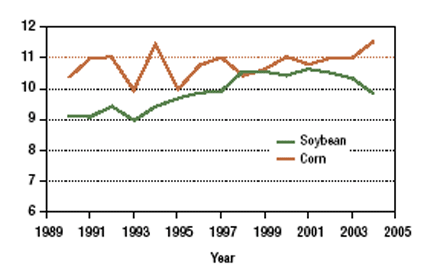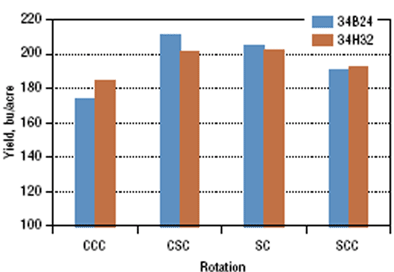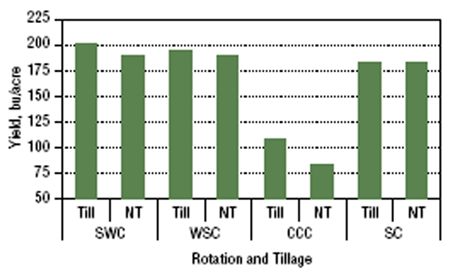Can We Rotate Our Way to Higher Crop Yields?
Despite the fact that Illinois producers were rewarded in 2004 for their persistence in growing soybean again after the low yields in 2003, there is a prevailing thought among some that the 2-year cornsoybean rotation is no longer "carrying the freight" with regard to cropping systems. Many feel that there must be a better rotation, involving variations of more corn at the expense of soybean, of third crops, and of other ways to return us to "yields like they used to be." Yields of both corn and soybean in 2004 were about 10 percent higher than their previous record-high yields in Illinois, but the advent of soybean rust and increasing seed costs have helped to direct thoughts to alternatives to this crop in recent years, even as expanded usage has increased the demand for corn. Acreages of corn and soybean in Illinois have fluctuated some during the past 15 years, with soybean occupying, on average, about 91.5 percent of the area that corn occupies. After several years of nearly equal acreages in the late 1990s, corn acreage has moved ahead of soybean acreage in the past two years (Figure 1). Acreage of both crops together has risen from about 20 to 21.5 million over the 15-year period since 1990, reflecting lower acreages of small grains, forages, and other crops. While there are certainly a number of other crops that will grow well in Illinois, we have seen few new crops that offer the stability and return that producers see in corn and soybean, and that use the same equipment and the same marketing channels as these two main crops. That doesn't mean there will never be such crops, but for today we will consider only established crops as candidates for new rotations. Of these, wheat has the best-established markets among crops familiar to Illinois producers. Hence we will limit our discussion to variations in length of the corn-soybean cropping sequence, and to rotations that include corn, soybean, and wheat. Can Continuous Corn "Learn" to Yield as Much as Corn after Soybean?Many producers, especially after very favorable corn years like 2004, feel that their continuous corn yielded as much as, if not more than, their corn that followed soybean. Many also feel that the second year of corn yields less than subsequent years, suggesting that growing corn for more than two years in sequence can somehow "cure" the yield loss from continuous corn. Most data do not support this contention, though it is clear that as corn follows corn over years, expectations may well change so that yields of corn following corn become more "acceptable," whether or not they are as high as they might have been if corn in the same field had followed soybean. As a way to look at this, we have been conducting corn following corn and corn following soybean comparisons in the same fields for the past seven years, with the first year a setup year in which corn followed soybean in most fields. Though yield loss from corn following corn showed a considerable amount of variability, there is no clear evidence of a trend in such yield differences over years in either northern or southern Illinois locations (Figure 2). Instead, we have seen some large yield differences-one in favor of CC (in southern Illinois) and several in favor of SC-occurring on an irregular basis. These data are similar to those reported from studies in other states. Does the Corn–Corn Soybean Crop Sequence Offer Better Returns than Corn-Soybean?In the data shown in Figure 2, excluding the very large yield difference in favor of CC in one year at Brownstown (BT) when SC yielded only about 20 bushels/acre, CC yielded about 9 percent less than SC in southern Illinois and about 12 percent less in northern Illinois. These numbers are in line with those reported from similar studies in other states. Faced with such yield losses, some have wondered if growing soybean every third year, followed by two years of corn, might not provide at least some of the benefit of soybean to both intervening corn crops, while at the same time perhaps increasing soybean yield compared to soybean following only one crop of corn. Some early results of such a study are shown in Figure 3. While results are needed over a number of years before we can have much confidence, these data show that yields of corn following just after soybean were the same in the 2– and 3–year rotations, and that yield of the second consecutive corn crop following soybean was considerably higher than the yield of continuous corn, which in this case was the fourth year of corn. There is also a hint that hybrid choice can influence the response of corn to such changes in rotation. The response of soybean to this rotation differed among locations; soybean following two years of corn yielded from 1 to 8 bushels/acre more than soybean in the corn-soybean. Based on these data, the corn-corn-soybean rotation seems to hold promise as a way to increase corn acres at the expense of soybean acres. Is a 3–Crop Rotation of Corn, Soybean, and Wheat Viable in Illinois?We initiated a long–term study at Monmouth and Perry, Illinois in the mid–1990s to compare continuous cropping of corn and soybean with the corn–soybean rotation and 3–crop rotations of corn, soybean, and wheat, one in which corn follows soybean that follows wheat (WSC), and the other in which corn follows wheat that follows soybean (SWC). Data from the last three years shows that corn produces higher yields in either the SWC or WSC rotation than in SC, especially when tillage is done (Figure 4). For reasons that are not clear, continuous corn in this study at Monmouth has yielded much less than rotated corn, such that continuous corn could scarcely be justified economically at this location. Soybean yields showed a similar response as corn, with higher yields in the 3–crop rotation. Wheat yield was higher when wheat followed soybean than when it followed corn, suggesting that the SWC rotation might be preferred. In addition, the 3–crop rotation, while not as effective as continuous corn in reducing SCN populations, resulted in some reduction in SCN numbers compared to the CS rotation. Summing up: Are We Getting There?There is clearly a tradeoff between higher (and more stable) yields from crop rotation and producing enough of the crop (corn, in this case) that people, livestock, and industrial processors need in very large quantities: one can't increase total corn production by switching large acreages out of corn into another rotation, unless that rotation produces much higher yields to compensate for reduced acreage. While the 2–year corn–soybean rotation is minimal in terms of complexity, it provides a considerable boost to corn yields compared to continuous corn, and we do not know how to eliminate this difference in continuous corn, though we can manage to reduce it to some extent. Due to financial incentives stemming from expanded usage, some producers are nonetheless increasing corn acreage at the expense of soybean acreage. Depending on world demand and supply of soybean, we anticipate that corn acreage may continue to increase at the expense of soybean acres in Illinois, though there will likely be some fields where yield penalties for corn following corn may be large in some years; the system may become less stable. The use of a 3–crop, corn–soybean–wheat rotation may offer some stability, but this would reduce overall production of corn, even as it increases corn yields. The 3–year corn–cornsoybean rotation has shown some promise of increasing both corn and soybean yields compared to some alternative rotations, though of course such a rotation means a reduction in overall soybean production. What changes in rotation individual producers might make in their own fields will depend on how well individual fields can support continuous corn compared to rotations, and also to management changes that producers are willing and able to make.
Tables & Figures
|
||||||||||||||||
Back to Classic 2005 |




